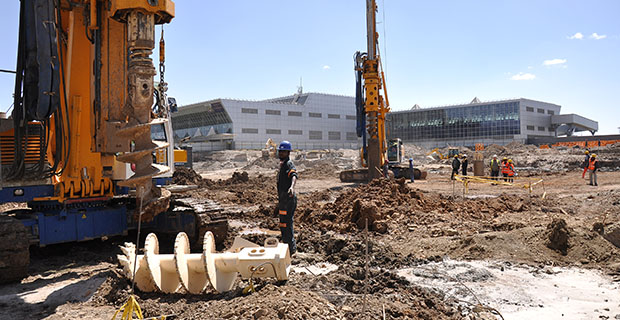
The Bole International Airport expansion project, which was planned at a cost of 225 million dollars, is now costing up to 340 million dollars as the scope of the construction has been stretched.
The construction, which was first planned to be completed in two phases, began with 225 million dollars secured by loan from the Export Import Bank of China (Chinese ExIm Bank), to finance the first phase of the project.
The plan for the first phase of the expansion was to enable the airport to accommodate up to 14 million passengers a year and the expansion construction was designed accordingly. The second phase was planned to raise the capacity from 18 million to 20 million passengers a year.
“The existing airport was constructed in 2003 to accommodate passengers for twenty years but it reached its limit after just 10 years,” Tewodros Dawit, chief executive officer (CEO) of Ethiopian Airports Enterprise (EAE) told Fortune.
After evaluating the demand for the airport facility for the coming 20 years, the first and second phases of construction were integrated so as to enable the construction to accommodate the estimated 20 million to 25 million passengers a year, according to Tewodros.
The Addis Abeba Bole International Airport, which used to accommodate less than a million passengers a year, can now handle over seven million passengers a year, according to Haylay G/Tsadik, deputy CEO of Airport Operations at EAE speaking at the Airport Infrastructure and Maintenance, Repair and Overhaul MRO meetings press conference.
The expansion construction that is now being carried out by China Communications Construction Company (CCCC) forced the Enterprise to integrate the two phases instead of embarking on a new expansion project in the near future. The design work of the expansion project was undertaken by a Singapore company, CPG Corporation Pte. Ltd., a building development and management services provider in the Asia Pacific region.
CCCC is the company that constructed the Addis-Adama Expressway and on June 25, 2014 it also won a bid to construct roads worth 2.57 billion Br. along the Omo River in the Southern Nations Nationalities and Peoples Region. CCCC is a subsidiary of the China Road & Bridge Corporation (CRBC), after the latter took it over in 2005. It has a presence in 50 countries
“When we decided the exact cost of the construction after the completion of the design after three years since it began in 2011/12, we saw that the demand had been increasing from time to time so we studied it again and integrated the first and the second phases of the construction,” stated Tewodros.
Although the additional cost of the construction is known, the source of the financing has not yet been determined and the Enterprise will request the Ministry of Finance and Economic Development (MoFED) to look for the finance, stated Tewodros.
“The contracting body might depend on the financing,” Tewodros stated.
The new expansion project is said to allow the airport to have the capacity of accommodating up to 20 million passengers a year in 15 to 20 year’s time.
“Thinking of another expansion after three or four years following the completion of the current expansion is not feasible,” Tewodros stated. “We will also work to finish the construction of the integrated phases within the first time-frame.”
In accordance with the changed design and cost of the expansion project, the physical work has also increased by 150pc, according to Hailu G/Mariam, EAE airport project head.
“The construction was expected to begin immediately after the plan was made three years ago and completed within five years; but as the designing took three years by itself, the demand increased more than the planned 14 million passengers a year,” Hailu told Fortune. “By the integrated expansion, at least we will have a breathing time until the demand exceeds that number.”
The total international aircraft movement at Bole International Airport between 2001 and 2010 grew by more than 240pc while the domestic aircraft movement grew by 12pc for the same period.
Currently, the EAE operates 20 airports, four of which provide international flight services while the rest provide services for domestic flights.
The deal with the construction company is based on a turnkey level in which the contractor constructs and submits the finalised project.
“The country’s tourism sector is still well untouched and the airport expansion facilities are one of the major requirements in the industry, which will facilitate the growth of the tourist industry,” Haile stated.
The expansion of the airport is also related to the Ethiopian Airlines’ 2025 vision, which includes increasing revenue to 10 billion dollars, increasing destinations from 104 to 126 and increasing fleet from 77 to 140, according to Tewodros.
The expansion project includes the construction of a new passenger terminal as an extension of the existing Terminal 1 (domestic and regional terminal) and Terminal 2 (international terminal) with related equipment. The new terminal will house boarding areas, lounges, recreation centers, shopping malls, offices and other facilities. New boarding gates, boarding bridges, and a new parking area for passengers and airport staff are parts of the expansion project as well. The other major component of the expansion project is the construction of a new VIP passenger terminal.






























